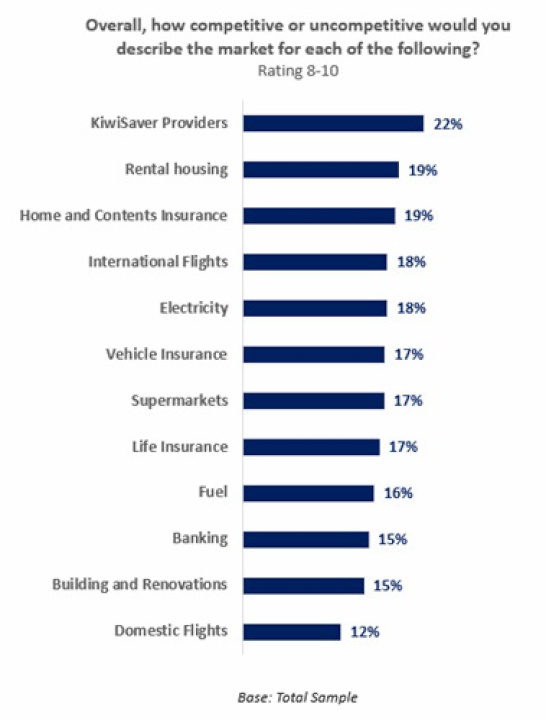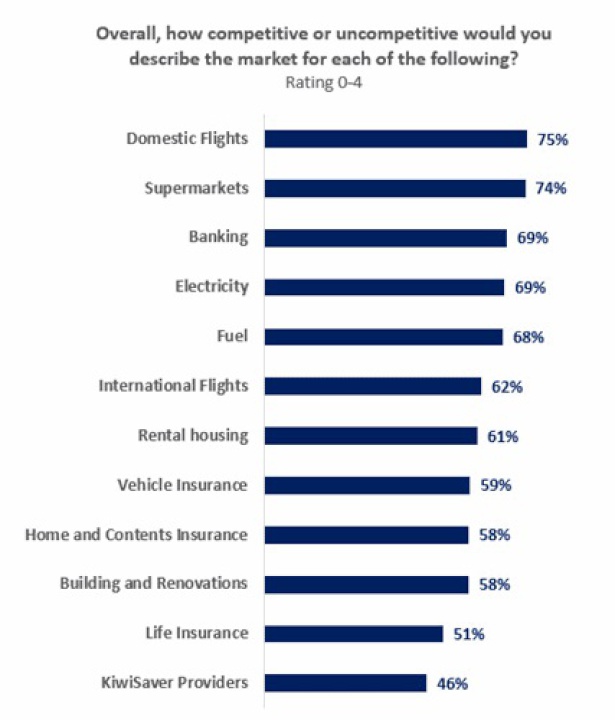New Zealanders Feel They Are Not Getting Fair Services And Prices
New Zealanders think most major product and services markets serving them are uncompetitive.
None of 12 markets measured by Horizon Research had a rating of more than 5.7 out of 10, where 0 was very uncompetitive and 10 very competitive).
New Zealanders rate domestic flights as the least competitive – with an average score of just 3.5 out of 10.
Supermarkets (rating score 3.6), banking (4.2), fuel (4.4), rental housing (4.5), electricity (4.6), building renovations (4.8), international flights (4.9) all had a rating of less than 5.
Horizon asked 1,020 respondents, representing the 18+ population: We'd like to know if you think there is enough competition to provide you with fair services and prices for some products and services...
They were then asked to rate the 12 markets.
Overall, the markets are not considered overly competitive, with four rating around 5.

KiwiSaver providers are considered the most competitive (mean score 5.7).
When looking at which markets score highly, between 8 and 10, overall ratings of 8 or above is generally low.
22% gave KiwiSaver providers a rating of 8 or above, followed 19% for rental housing.
Domestic flights had the lowest score at 12%.
How they rank 8 plus out of 10

How they rank 4 or less out of 10

The majority of respondents gave the markets low ratings for competitiveness scoring them a 4 or below.
KiwiSaver providers was the only market where less than half scored it 4 or below.
75% scored domestic flights below 4 for competitiveness, followed by supermarkets at 74%.
Horizon, which commissioned the survey as part of its public interest programme, says results clearly show New Zealanders perceive there is not enough competition in key markets to provide them with fair services and prices.
Methodology
The survey was conducted nationwide between March 22 and 26, 2024. There were 1,020 respondents aged 18+, representing New Zealand’s adult population. The data was weighted on age, education, ethnicity, personal income and region to match the adult population.
At a 95% confidence level, the survey has a maximum margin of error of ±3% overall.


 NIWA: Flooding From Underneath - New Tool Reveals Shallow Groundwater Elevations
NIWA: Flooding From Underneath - New Tool Reveals Shallow Groundwater Elevations Commerce Commission: Commission Concludes Auckland Airport Over-charging By $190 Million
Commerce Commission: Commission Concludes Auckland Airport Over-charging By $190 Million The Future Is Rail: Ferry Decision - Common Sense Prevails
The Future Is Rail: Ferry Decision - Common Sense Prevails Aotearoa Food Rescue Alliance: Grocery Market Reform Must Include Mandatory Food Rescue Partnerships
Aotearoa Food Rescue Alliance: Grocery Market Reform Must Include Mandatory Food Rescue Partnerships Hugh Grant: Zero Trust Security - A Buzzword Or The Ultimate Protection?
Hugh Grant: Zero Trust Security - A Buzzword Or The Ultimate Protection? Bill Bennett: Comcom revisits fibre rules as competition intensifies
Bill Bennett: Comcom revisits fibre rules as competition intensifies



